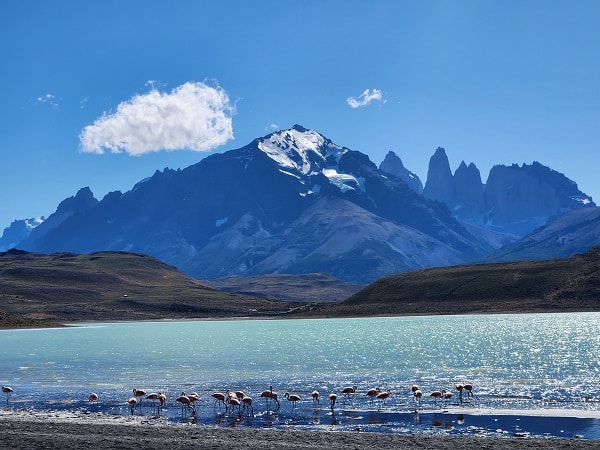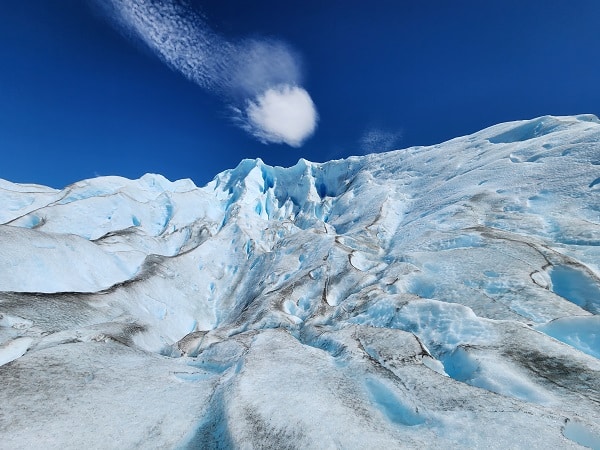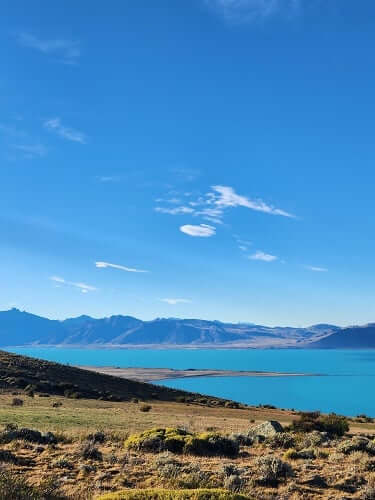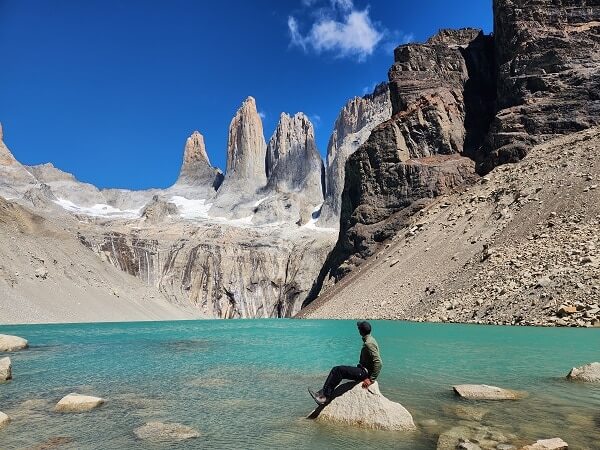It’s no secret that Patagonia is home to some of the world’s most breathtaking landscapes. Nestled between Chile and Argentina, the largely untouched region features the southern section of the Andes mountains, woven together with a rich tapestry of lakes, glaciers, steppes and deserts.
Patagonia is safe, even for solo travelers; the area has low crime rates, the roads are well-maintained and, if you need help and don’t have access to Google Translate, English is commonly spoken in most Patagonian towns.
In quintessential Sydneysider fashion, I’ve overloaded my South America itinerary to justify the 26-hour journey. It means I’m only scheduled to spend four days in Patagonia, rather than the ideal two weeks.

Torres del Paine National Park (Chile)
On arriving at Punta Arenas – a stop on Chile’s famous End of the World Route – I’m warned by the rental car operator: park into the wind, and open doors carefully, because the region’s notoriously strong gales can pull car doors clean off. Thankfully, my Toyota Corolla Cross does not deconstruct itself, so my three-hour drive up to Puerto Natales, the gateway to Torres del Paine National Park, proceeds without incident.
I spend the afternoon driving through the meandering park, stopping briefly at the Cueva del Milodón, a large cave that was, over 10,000 years ago, home to a species of giant sloth.
The drive is spectacular, and I’m grateful that I hired an SUV and took out additional insurance: rock chips are all but guaranteed on the park’s gravel paths.
The next morning, I start the coveted Mirador Las Torres hike at 6am. It’s a 21km, 10-hour return journey culminating in perhaps Patagonia’s most famous view: three towering granite pillars, the eponymous Torres Del Paine, rising sharply above a pristine turquoise lake.
It’s a grueling hike, especially for someone who is trigger-happy with the “Request UberX” button. The weather is unpredictable, and the terrain is varied and steep – particularly the last hour, which sees you scrambling over boulders and generally traversing rocky, exposed moraine.
But the journey is utterly worth it. After nearly four hours of climbing, the peaks of the three towers suddenly appear high above me, as though conjured into existence. I’m immediately struck with that profound sense of insignificance that only nature can evoke.
By the time I’m ready to leave – having re-filled my bottle with ice-cold glacial water as is customary – the viewpoint is suddenly busy, and hordes of people are stuck in traffic on their way up. It’s a reminder that this hike is best done early in the day.

El Calafate (Argentina)
I spend my last two days in Patagonia in the Argentinian town of El Calafate, a five-hour bus ride from Puerto Natales.
Calafate is home to the Perito Moreno glacier, a staggering 258 square km mass of 80-metre high ice seracs and glacial cracks. The glacier, which began forming 2.6 million years ago, is the third largest reserve of fresh water on the planet (after Antarctica and Greenland). The glacier advances 2 metres each day, so the ice at its front – large slabs of which regularly crack off and crash thunderously into the awaiting lake – is estimated to be 18,000 years old.
I’m with a guided tour which takes visitors “mini-trekking” on the glacier. It’s an other-worldly experience that’s essential to book in advance (and a novelty for Australians, as inhabitants of the only glacier-free continent). If trekking on ice with cramp-ons is not for you, you can take a boat ride to the glacier, or view it from a labyrinth of observation decks – it’s here where you can best appreciate the sheer magnitude of the glacier.

As my time in Patagonia draws to an end, I book a last-minute 4WD tour of Cerro Frias. It’s a steep and somewhat gnarly drive, but the famous Patagonian blues are comforting. We finish with dinner at a private ranch, watching the sun set over the vast Patagonian wilderness.
How to get there: Fly direct to Santiago from Sydney, then fly to Punta Arenas (or El Calafate, via Buenos Aires). From there, rent a car or use the region’s excellent bus network to your base.
What to do: For seasoned hikers, conquer the W Trek in Torres Del Paine. If you’re adventurous, but short on time, hike to the Mirador Las Torres, or to Mount Fitz Roy from El Chalten.
Not a hiker? In El Calafate, visit the Perito Moreno glacier, and join a 4WD tour to the top of Cerro Frias.
When to go: Patagonia is brutal in winter, so visit during the warmer months, between November and March. It can still get cold, so layer your clothing.
The dollars and cents: Expect to pay between AUD$4,500 to $6,500 for two weeks in Patagonia, the majority of which will go towards flights and accommodation. If you’re on a budget, Argentina is significantly cheaper.




